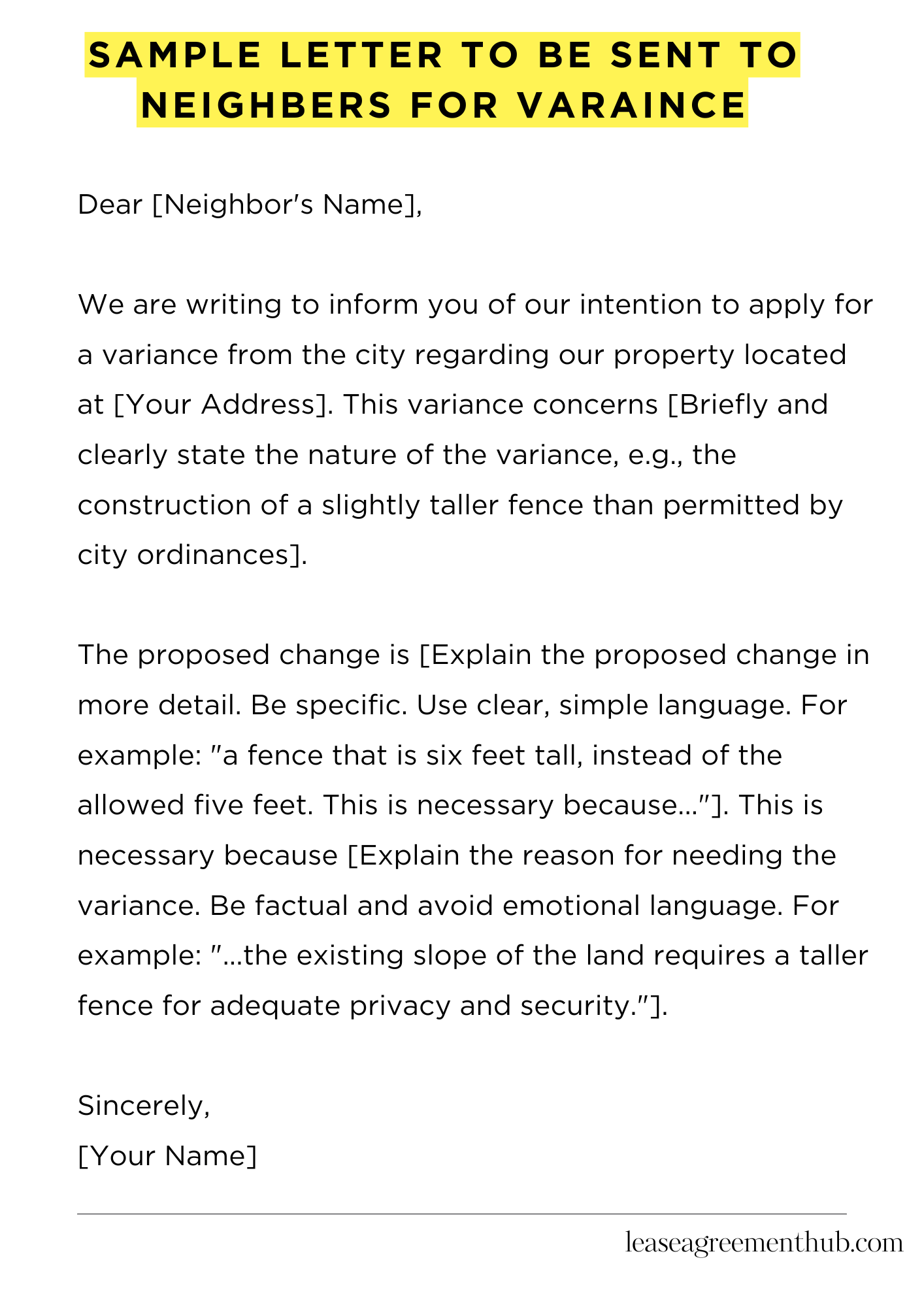Are you in need of a sample letter to send to your neighbors for a variance request? Look no further! This article will provide you with templates and examples to make the process quick and easy.
We understand that writing a letter to your neighbors can be daunting, which is why we have compiled a variety of sample letters for variances to help you get started. Whether you are seeking permission for a construction project or a zoning change, we have got you covered.
With our collection of sample letters, you can easily customize and personalize your message to fit your specific needs. Say goodbye to the stress of composing a letter from scratch and let our templates guide you in the right direction.
Sample Letter to be Sent to Neighbors for Variance
[Your Name]
[Your Address]
[Your Phone Number]
[Your Email Address]
[Date]
[Neighbor’s Name]
[Neighbor’s Address]
Dear [Neighbor’s Name],
We are writing to inform you of our intention to apply for a variance from the city regarding our property located at [Your Address]. This variance concerns [Briefly and clearly state the nature of the variance, e.g., the construction of a slightly taller fence than permitted by city ordinances].
The proposed change is [Explain the proposed change in more detail. Be specific. Use clear, simple language. For example: “a fence that is six feet tall, instead of the allowed five feet. This is necessary because…”]. This is necessary because [Explain the reason for needing the variance. Be factual and avoid emotional language. For example: “…the existing slope of the land requires a taller fence for adequate privacy and security.”].
We understand this may affect you. We want to address any concerns you may have. The variance request itself is fairly straightforward. We believe it will not negatively impact your property or neighborhood. We are happy to discuss this further with you at your convenience. Please feel free to contact us to schedule a time to talk. We value your input and your understanding.
Sincerely,
[Your Name]

How to Write a Sample Letter to be Sent to Neighbors for Variance
Understanding the Nuances of Variance Requests
Before penning your missive, thoroughly grasp the intricacies of variance applications within your local jurisdiction. Regulations vary widely. Consult your municipal building codes and zoning ordinances. Ignorance of these legalities could jeopardize your application. Familiarize yourself with the specific requirements for submitting a variance request. This proactive approach will significantly improve your chances of success.
Crafting a Compelling Salutation and Introduction
Begin with a formal salutation, addressing your neighbors by name if possible. A generic “To Our Valued Neighbors” is acceptable if individual names are unavailable. Immediately state the purpose of your letter; clarity is paramount. Avoid circumlocution. succinctly explain your intention to seek a variance for [state your project concisely, e.g., a minor setback reduction].
Articulating Your Case with Precision and Persuasion
This section forms the heart of your letter. Present your case cogently, avoiding emotional appeals. Provide a detailed explanation of your proposed project and why a variance is necessary. Highlight the demonstrable benefits, while acknowledging any potential drawbacks. Use quantifiable data whenever possible, fortifying your arguments with concrete evidence. Emphasize the minimal impact on neighboring properties.
Addressing Potential Neighborly Concerns Proactively
Anticipate possible objections. Preemptively addressing potential concerns demonstrates forethought and consideration. For example, if your project involves increased traffic, propose mitigating solutions like designating specific parking areas. This proactive approach fosters goodwill and strengthens your appeal. Remember, conciliation is key to a successful outcome.
Maintaining a Professional and Respectful Tone
Maintain a courteous and respectful tone throughout your letter. Avoid accusatory or confrontational language. A conciliatory approach is far more effective than an adversarial one. Your aim is to persuade, not alienate. Remember, you are requesting a favor, not demanding a right.
Concluding with a Call to Action and Contact Information
End your letter with a clear call to action. Suggest a meeting to discuss your proposal further. Provide your contact information—phone number and email address—making it easy for neighbors to respond. A concise and polite closing, such as “Sincerely,” is appropriate.
Review and Refine Before Sending
Before dispatching your letter, meticulously review your work for any grammatical errors or inconsistencies. A second pair of eyes can be invaluable. Ensure clarity and conciseness are maintained throughout. A well-crafted letter reflects your professionalism and respect for your neighbors’ concerns. This final step will significantly impact the letter’s persuasive power.
FAQs about sample letter to be sent to neighbors for variance
What information should I include in a letter requesting a variance from my neighbors?
Your letter should clearly state your request for a variance, the specific variance you’re seeking, a brief explanation of the project, and how it might affect your neighbors. Include your contact information and offer a time for them to contact you with any questions or concerns.
How formal should my letter be?
A semi-formal tone is generally appropriate. Avoid overly casual language, but also avoid overly stiff or legalistic phrasing. Maintain a polite and respectful tone throughout.
Should I offer to address any potential neighbor concerns?
Yes, proactively addressing potential concerns demonstrates good faith and consideration. For example, you might mention steps you’ll take to mitigate noise, traffic, or other potential impacts.
When is the best time to send the letter?
Send the letter well in advance of submitting your variance request to the relevant authority. This allows time for neighbors to review the information and contact you with any questions or concerns before a decision is made.
What if my neighbors are opposed to my variance request?
Be prepared to listen to their concerns and address them respectfully. Consider offering compromises or modifications to your project to alleviate their worries. If opposition remains, be prepared to present your case to the relevant authority.
Related: